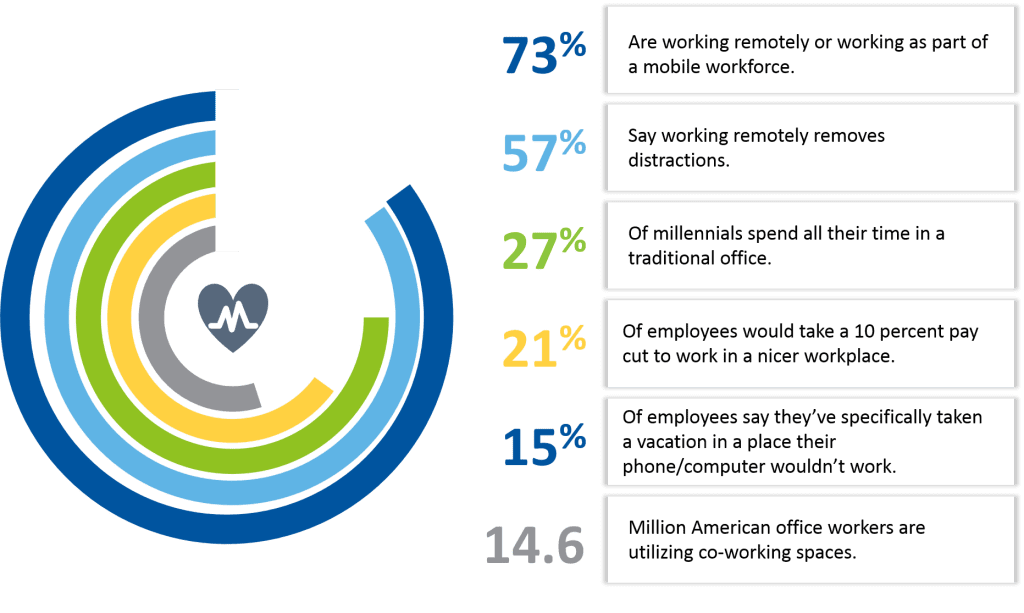Look to Millennials to Plan the Best Unified Communications Experience

As Unified Communications (UC) continues to evolve under the BCStrategies.com definition, “Communications integrated to optimize business processes,” I ponder where UC will ultimately end up and what it will look like. UC tools like collaboration, chat, audio conferencing, videoconferencing, Unified Messaging, UC mobility, presence, and corporate directory all offer multiple ways of communicating in real-time. IoT now offers real-time access to devices and manages an entire field workforce more efficiently. AI will create new opportunities for customer experience and SLAs by adding ‘bots’ to Contact Center chat functions and now voice functions with the introduction Google Voice and other partnerships. We can now all be connected in real-time no matter what the media. I believe we’ve seen just “the tip of the iceberg” of what UC will eventually become.
As UC continues to go mainstream as a now ‘must’ for many enterprises, there are hints as to why it will proliferate at outstanding growth rates. According to PWC.com, “Millennials matter because they are not only different from those that have gone before, they are also more numerous than any since the soon-to-retire Baby Boomer generation – millennials already form 25% of the workforce in the US and account for over half of the population in India. By 2020, millennials will form 50% of the global workforce.”
So within the next three years, millennials will account for nearly 50% of the workforce. That’s a HUGE statement as to the ultimate outcome of how UC will be embraced, and what it is going to look like. My sons, both millennials, happen to be fellow consultant staff members. Their insights can be important, as they know how their generation works.
Millennials can be, in fact, your greatest advocate for deploying UC in your own organization. Millennials help identify to the ultimate UC tagline: “Anytime, Anywhere, Any Device.”
Millennial Traits
Here are some of the traits I see in how UC can fit invariably well with millennials:
Mobility
Millennials now fully embrace a mobile world, working anywhere via mobile devices, including smartphones and tablets. These tools are now a part of everyday life, as a means of being connected full time, well beyond the traditional 9-5 work day and 40-hour work week. Mobile UC clients now supply the tools necessary to embrace a full UC suite experience at the smartphone and tablet device level.
Immediacy
Millennials not only want access to information, they want it immediately. Tools such as presence and IM/chat help provide that, and now next-gen UC tools such device awareness, geo-location presence, and powerful search tools as a part of the “conversation” help continue to satisfy that need. Additionally, click-to-call and conferencing can ensure that millennials will have seamless access to any kind, any type of communication, anywhere, anytime.
Millennials Can Work From Anywhere
Millennials are familiar with working and communicating from anywhere without a major adoption curve. Ideally millennials like to work from home some days during the week, or for that matter work from anywhere (e.g. Starbucks, hotel, etc.). And from contact center staffing polls, most workers at large (millennials, GenX, Baby Boomers) would prefer a flex work environment to improve the quality of their lives. Creating a “virtual branch office” (working from anywhere) can offer any staff member or partner the ability to work with a team from literally anywhere, from any device (e.g. desktop telephony, laptop, PC desktop, smartphone, tablet, room-based video conference).
A Craving for Knowledge
Millennials have an incredible appetite for knowledge, data, and information. Next-gen UC tools can provide access to such knowledge bases with access to historical and current real-time internal databases for staff – this provides an advantage in tracing the history of a topic, or of an issue.
Embrace Today’s Technology
While Baby Boomers have grown up in an age of TV, millennials have grown up in an age of the Internet, PCs/laptops, Wi-Fi, 4G (and now soon to be 5G), and social media. These tools have already been a part of their lives growing up.
Millennials Are Technologically “Social” and Collaborate as a Function of How They Live
Millennials embrace social media tools in the consumer world, and collaborate, share screens, conference, and create virtual teams in a real-time gamer’s world. UC tools allow millennials the ability to collaborate full time, in real time, sharing information quickly and ultimately effortlessly. Millennials want to share information and collaborate quickly, providing solutions to issues much faster than organizations experience in a non-UC environment.
Recent Staples Poll
According to a recent Staples 2017 survey, telecommuting and remote working have clear advantages for the workforce, removing distractions, reducing real-estate costs, creating better mental health at large, and in my opinion, especially when it comes to millennials.
From the employee poll, it is shown that:

From the employer poll, it is shown that:

By implementing UC as part of an organization’s strategic plan, millennials (and all staff really) will have the freedom to work using any device anytime, anywhere, creating a domestic and even worldwide “virtual organization” environment. In my opinion, this kind of flexibility heightens the chances that an organization can attract more millennials and retain them longer. By empowering millennials with UC tools, real-time communication expands exponentially across any device, and further drives innovation in the marketplace.
Conclusion
If you are looking for the “perfect” long-term UC strategy, start with the traits of the millennials, who will be the single biggest driver towards UC adoption going forward as they become the 50+% majority of the workforce shortly. The traits and behaviors of millennials should be adopted by your own organization, keeping in mind that it will take some time to “shift” a culture from a “brick and mortar” mindset to a “virtual organization” mindset.
Those that adapt now will win the game of UC in their respective vertical markets, leading their competitors by as much as 12-24 months by adopting UC as a strategic component of their business communication, which will further drive their timely, expedient delivery of their respective products and services. UC tied with customer experience, in my opinion, is not only transformational for any organization, but existential longer term – just ask organizations who have not transformed their organizations from a brick and mortar environment to a virtual organization, including Toy-R-Us (closed), The Bon-Ton (closed), Sears (Chapter 11), Payless Shoes (closed 800 stores in 2017), The Gap (closed 200 stores in 2017), and Gymboree (closed 350 stores in 2017) among others.
It is now truly a highly competitive and existential game in the market, and UC tools are a ‘must’ for survival and getting ahead of the competition, period.
Do you need help implementing UC at your business? Vertical can help!



